Contents
Overview about Sapa and its Five Ethnic Groups
Sapa is the first destination of mountain travelers coming to Vietnam. As a travel destination, Sapa provides all the necessary services with local people that have learned the English language and love to practice. You can find the best homestays, trekking tours, shopping in local markets, and multiple interesting places and activities in Sapa. First, check out our comprehensive guide to visiting Sapa which includes all the importation information you need to begin.
I don’t remember where I heard this sentence, but it really suits Sapa: The first time you travel to a land is because of its beauty. The next time you travel is because of the local people. Local people in central Sapa usually lure travelers only to buy their wares and they ultimately leave a bad impression on travelers. However, it’s just a small portion of the people, and you should not attribute this to the entirety of Sapa. If you travel to remote villages and meet lovely people there, you will get a good idea of their hospitality and distinct cultures.
But I’m not here to discuss these cultures broadly, I am here to inform you a little bit about the clothes you might see during your travels. The colorful clothes of each ethnic group will impress you at first glance. Did you know that Sapa is home to five ethnic groups, including H’Mong (Mong Den), Dao Do, Tay, Xa Pho, and Giay people? Their colorful clothes are not only what they wear day to day, but they also display their traditions and have particular meaning. Read on to discover a little bit about these cultures before your travels to this beautiful part of Vietnam.
H’Mong (Mong Den)
The H’Mong people are the biggest population in Sapa, they make up around 53 percent of the population. Mong Den, a branch of the H’Mong group, live mainly in Sapa. Mong Den means Black Mong, because they mainly use dark colors in their traditional clothes.
The main colors of the Mong Den’s clothes are green and purple. They usually use big patterns depicting images of their daily life, which is embroidered on the collar or belt. Their main patterns are instruments of labor, animals, trees, and flowers. Pumpkin flower, aniseed, pig’s trotter, and spinning wheel are usual patterns reserved for the skirt, handkerchief, and blanket. Mong girls wear the skirts, the handkerchief is given to the young girls by their boyfriends, and the blanket is a gift given to the dead.
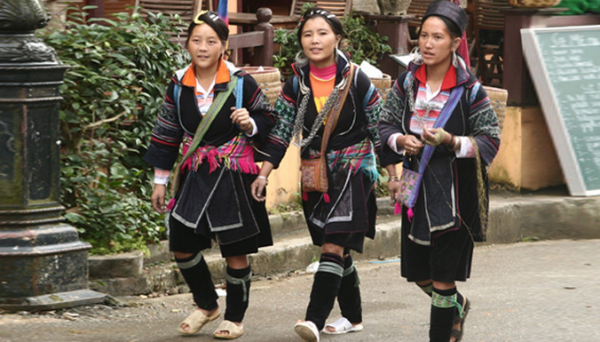
How to Make the Cloth
H’Mong people use three techniques to create patterns.
Embroidery is the main technique used nowadays because it saves time and doesn’t require absolute precision. The H’Mong girls usually embroider the letter “x” to create a pattern or combine many colors together. Each pattern is unique, creative, and diverse.
The H’Mong also cloth graft in which pieces of colorful cloth are sewn together. This technique creates nice borders to highlight the embroidered patterns. The main colors are red, blue, green, and white.
The final and most special technique is beeswax. H’Mong girls draw directly on linen using beeswax. When the pattern is drawn, it can’t be altered anymore, so this technique requires absolute precision. After the drawing is finished, the cloth is then dyed in indigo. Indigo is a natural dye extracted from indigo leaves and it has a strong smell that keeps away insects and leeches. It usually takes two to three months to finish dyeing a large piece of cloth. The cloth should be dyed twice to retain the strongest color and hold the shape longer. This technique seems to have fallen into oblivion over time because of its complexity and high demand.
Clothes of Men and Women
Men usually wear shirts down to the waist or lower, with wide sleeves. Some shirt designs do not have decoration, but some are decorated with stripes on the sleeves. Men’s trouser legs are very big compared to other groups in the area. They usually wear a scarf, or hat decorated with silver circles engraved with patterns, or silver necklaces.
Women traditionally wear a shirt, skirt, skirt cover, belt, and leggings. The women’s shirts have a V-shaped front collar, which is trimmed with additional fabric. A rectangular embroidery on the back is decorated with elegant patterns and has silver coins attached, which makes a fun sound when the women walk. The sleeves are usually embroidered with horizontal stripes in all colors from the shoulder to the arms. This is the place where the pattern is most prominent in order to highlight the shirt.
The skirt is an open skirt, with many folds, widely spread like a petal. It is often sewn to fit a waist and has two straps to fasten. The patterns, embroidered and grafted from different cloths, are on the bottom half of the skirt. The belt and leggings of the costume express the thoughtfulness and privacy of a woman. As you can tell the women are the most ornamented, they even wind their long hair around their head and fasten a colorful kerchief to their head.
Dao Do
The Dao Do people are the second largest population after H’Mong people in Sapa. Dao people choose the valley or halfway up the mountain to plant corn, rice, and cardamom.
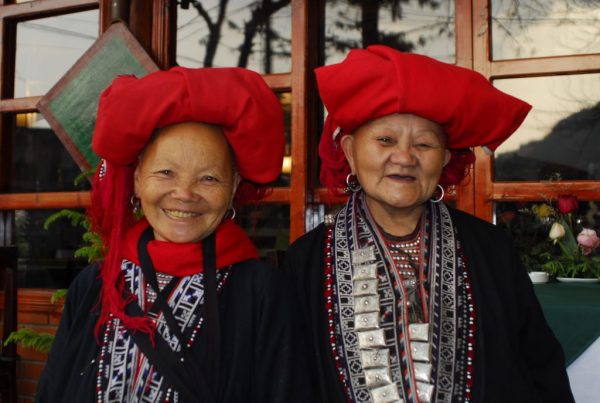
How to Make the Cloth
Dao people often sow seeds in January and February to avoid frost. When they harvest the cotton, they boil it, soak it in cold water, and wrap them into separate cotton packs. The loom is the main tool used to create Dao traditional clothing and many families will have one in their homes. When Dao girls are young, their mothers teach them to sew and embroider. These girls learn both simple and complex steps such as small details like how to dye the indigo cloth after it fades.
Clothes of Men and Women
Dao Do men have two shirts: short and long. The pattern of the short shirt is focused mainly on the chest, neck, and back of the shirt. With the long shirt, silver flowers studded between two rows of red wool balls stand out against the Sapa landscape.
The patterns on the pants are more elaborately embroidered. The lower half of the trousers are red, yellow, and white with rectangular, pine, and swastika symbolism. The upper half of the trouser is totally black and wrapped with rope and a belt, whereas the lower patterned part of the trouser creates a harmonious balance in the entire outfit.
Dao Do women can choose five basic colors, but they must always wear red. A complete costume of the Dao includes a shirt, pants, belt, silver jewelry, and a headscarf.
The most important aspect is the long dress. Dao Do women do not wear short dresses. The sleeves and the edge of the front and back of the dress are embroidered in red and white and are studded with beads and red tassels. Two pieces of cloth are embroidered separately and attached to the edge in the front and back side. This creates the impression that there are two nested dresses and the outer dress is shorter than the inner dress.
The clothes are colorful with many kinds of patterns such as swastika, pine, bird, human, animals, leaves, etc. In particular, Dao Do embroider the pattern on the cloth completely based on their memory. The pattern is embroidered on the inside of the cloth so it emerges on the outside.
Inside the long dress, Dao Do women also wear a thin cloth, like a brassiere. It is open at the back of the neck, covers both the chest and abdomen, with embroidered lines in white and yellow. A small strip of fabric is used to tie the back.
The headscarf is decorated with a tiger foot and the shape of a geometric figure. It also has five layers. When women wear the scarf, the pattern of the five layers is on the outside, creating the beauty of the scarf.
Dao Do women also prefer jewelry to make their outfits more luxurious such as a necklace, rings, betel bag, silver hemisphere jewelry, and eight-winged star. Some women wear ten necklaces, twelve rings, and big silver buttons to highlight their costume and the indigo color. However, some women barely wear any jewelry at all.
Tay
Tay people mainly live in the south of Sapa, a place of fertile valleys, suitable for fishing and farming.
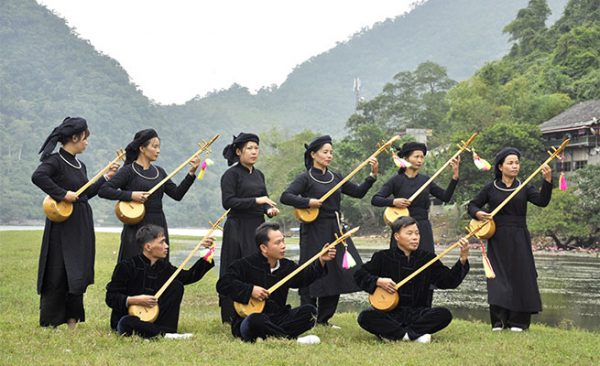
How to Make the Cloth
Tay costumes are made from cotton dyed indigo with little to no decorative pattern. The main materials for brocade weaving are indigo dyed cotton and dyed silk. However, the price of silk is expensive today, so Tay people use wool which is cheaper to replace. Weaving brocade is completely done by hand and used to make blankets, bed sheets, and traditional costumes.
Clothes of Men and Women
Men usually wear white thin shirts inside during the holidays and long shirts outside which is split on the right side and tied by fabric or a bronze button. They also have a different shirt, which is split in the middle, has a high round neck collar, two small bags in front, and is fastened with fabric buttons. The men’s pants are also made of indigo dyed cotton. The pants have a wide pant leg, and interestingly, there is no elastic band, instead a lanyard is tied like a belt to keep the pants up. And this time, the men actually wear an indigo head scarf wrapped on top of their head.
The Tay women’s costume consists of a thin shirt, long dress, skirt, belt, head scarf, and fabric shoes. The belt is made of indigo cloth two arm lengths long. Like men, Tay women usually wear white shirts on the holidays.
Traditionally, Tay women wear skirts, but pants are more popular recently. Different to men’s pants, the women’s pant leg is usually smaller. Tay women also wear an indigo square head scarf, diagonally folded to cover the head.
Jewelry is simple. There are necklaces, bracelets, and anklets. You will also often see a betel bag on their hip. However, the most important piece of jewelry is the woman’s necklace. It is a large silver O-shaped necklace, stretching to a quarter down the chest, highlighting the indigo dress.
Giay
Giay people live in the valley villages such as Ta Van and Lao Cha, and they only make up two percent of the population of Sapa. Their main job is wet rice cultivation.
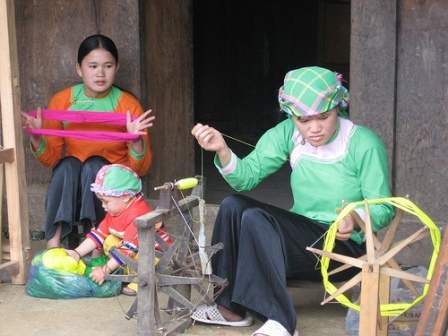
How to Make the Cloth
Giay people do not spend much time making cloth. Most of the people buy fabric and make cloth in a simple way, so most women have more time to take care of other jobs such as raising livestock and farming.
Clothes of Men and Women
Compared to other ethnic groups, Giay traditional clothes are more simple, less embroidered, and only have colorful bands around the collar and edge of the clothes.
Giay men often wear the indigo dyed shirt, split in the chest, with a round neck, standing collar, and fabric button. Jackets usually have three bags, including one bag on top of the right and two lower bags. The jacket is short and slightly indigo. The trousers have a firm and long trouser leg. Some men wear a head scarf, and some put their long hair in a bunch.
Giay women wear shirts split on the right side, with wide sleeves, and colorful fabric grafted on the sleeves. The broad skirt covers the knee. The inner shirt is short-sleeved, split in the chest with a low round neck collar, and has two lower pockets. Giay women often wear a silver O-shaped necklace and colorful scarves in various styles. The shoes are embroidered with delicate patterns, which are the symbol of a couple’s happiness such as butterflies, ducks, and peach flowers. However, Giay women don’t wear much jewelry. Only a bracelet or a silver necklace is enough.
Xa Pho
There is a small population of Xa Pho people living in Sapa. They live in the villages of Nam Sai commune, in a remote place in the south of Sapa district. The street to this village is difficult, so they do not often have contact with the outside.
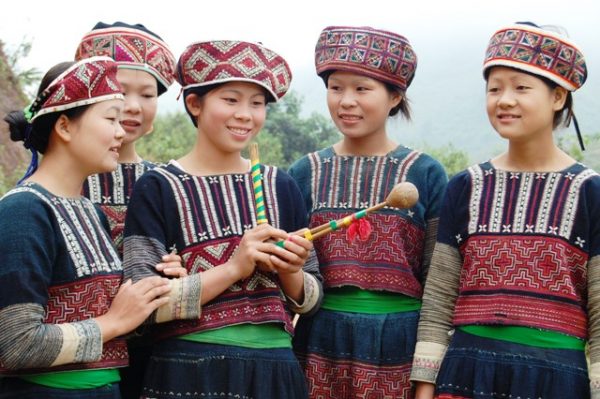
How to Make the Cloth
Xa Pho patterns are a sign of originality, each pattern is decorated according to the creativity of each person. But these patterns are completely embroidered by hand, which takes an average of one year to complete a full costume. The costume is handmade with cotton that is then woven, embroidered, and dyed. These techniques are similar to other ethnic groups.
Clothes of Men and Women
The Xa Pho men’s costume includes a headscarf, shirt, trousers, and belt. The shirt is black, split on two sides, and red and yellow threads are embroidered near the bottom of the shirt. Studded white beads line the back or the edge of the shirt. The wristband is also decorated with patterns of plants, grass, and various types of borders. Like Tay people, the trouser has no elastic band, instead a lanyard is tied like a belt to keep the pants up.
The Xa Pho woman’s costume consists of a head scarf, shirt, skirt, and belt. Women wear a short shirt and long skirt. Both of these pieces of clothing are embroidered. The shirt is a type of undershirt with a square collar, same in the front as the back.
The pattern on the shirt is divided into two distinct parts. From the neck down to the chest are four white beads, twisted patterns with black, blue, red, and white. The lower part of the shirt is embroidered thickly with a symmetrically geometric pattern such as squares, triangles, and olive shapes. The sleeve is just embroidered near the wrist with patterns such as twist, geometric shapes, bird’s eyes, pheasant’s eyes, fern leaf, triangle, and rectangle. All the colors are harmoniously coordinated, but dark red is the dominant color.
The skirt is grafted with two pieces of indigo dyed fabric and decorated with elaborate patterns along the length of the skirt. The pattern near the bottom of the skirt is embroidered colorfully with rhombuses. The bottom of the skirt is embroidered with pine trees, water, sawtooth, and crossed triangles.
The belt is made of white cloth with many tassels at the end. Jewelry includes silver necklaces, earrings, and bracelets. The colorful headscarf becomes a highlight of the costume, which makes Xa Pho women look more attractive.
Where to Buy Traditional Clothes in Sapa
Traditional clothes and brocade souvenirs in Sapa are handmade by the local ethnic women, with good quality fabric. I have compiled a good list of places to find these clothes and fabrics.
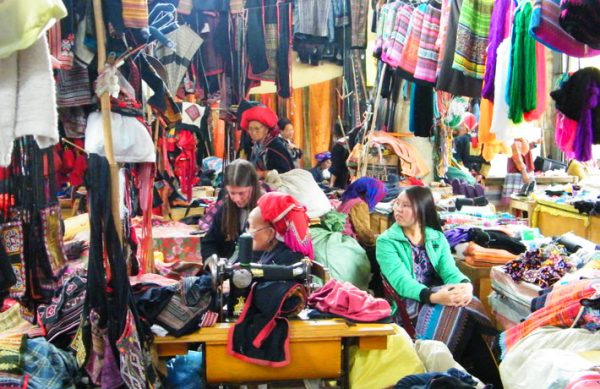
Ta Phin Brocade Village
Address: Ta Chai Hamlet, Ta Phin Commune, Sapa
Sapa Love Market
Address: In the center of Sapa town, next to Stone Church of Sapa
Pho Nui Sapa Shop
Address: 13 Cau May Street, Sapa
Hue Silk Sapa
Address: 24 Cau May Street, Sapa
Now you can travel to Sapa and understand the different cultures and their clothing. See the differences between the men and women, look at their head scarves, or lack of jewelry and become an educated traveler. Check out this article to get an overview of your Sapa trip. If you want to learn more about these cultures, check out this article detailing the specific villages you should visit, and then give this article a look to read the first installment of the detailed story and culture of the H’Mong and Red Dao people.
If you enjoyed reading this article and would like some more fun info about what to see, do and eat (and a bunch of interesting cafes!) in Vietnam, follow us at the 4U Trip!
